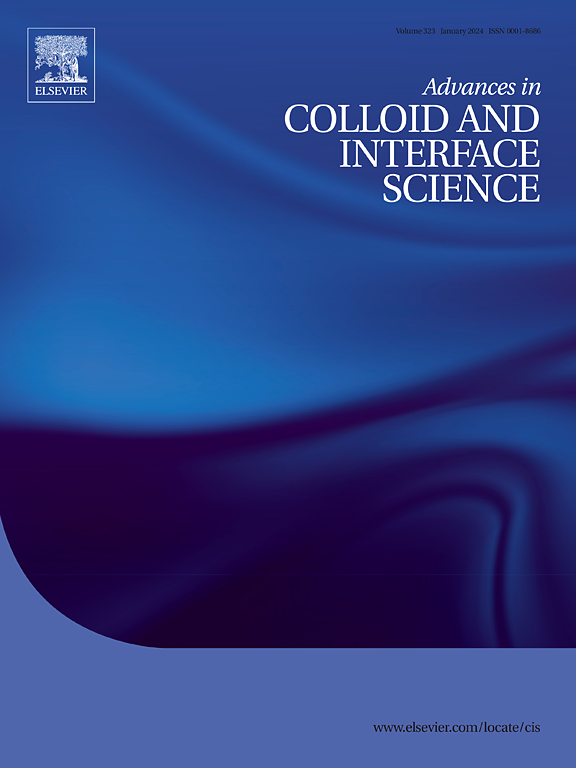液-液界面的电动力学:物理模型和输运机制
IF 19.3
1区 化学
Q1 CHEMISTRY, PHYSICAL
引用次数: 0
摘要
一个多世纪以来,非混相液-液界面上的起电效应和电动力流动现象一直是科学研究的主题。与固液界面不同,液液界面不仅具有多物理和跨尺度特性,而且具有弥散软特性,包括有限厚度、流动性、离子吸附性和渗透性,这引入了不同的界面充电机制和导电介电特性,赋予了电动多相流系统独特的特性。电动力学多相流体动力学(EKmHD)以电化学、胶体和界面科学为基础,近年来引起了人们的重新关注。这在诸如电化学中两种不混溶电解质溶液(ITIES)之间的界面、物理化学流体动力学中的自推进液滴和电力学中的数字微流体等系统中尤为明显。带电液-液界面的多相扩散软特性引入了新的物理尺度和理论维度,使EKmHD成为一个新的跨学科领域的潜在基础,而不仅仅是一个跨学科领域。这篇综述强调了需要一种综合研究方法,将界面充电机制与电动流动结合起来,以及界面多物理输运的跨尺度建模框架。从充电机制和电动力学行为的角度系统地组织了液-液界面的特征,特别强调了界面上自发分配和吸附诱导的充电,以及多相弥漫性软界面流动与离子输运之间的强耦合。在此基础上,从界面离子输运和流体流动两方面全面总结了电动多相流输运机理,并细化了相应的主要无量纲参数。此外,它系统地巩固了目前对典型的电动多相流场景的理解,特别关注潜在的未来研究方向。其中包括电动力学双面耦合效应、液滴/气泡电泳中的凝固和非线性效应、漏电介质模型的有效性、射流和离子选择性软界面的电动力学不稳定性以及两相电动力学润湿动力学和位移的主动和被动控制。本文章由计算机程序翻译,如有差异,请以英文原文为准。
Electrokinetics at liquid-liquid interfaces: Physical models and transport mechanisms
The electrification effects and electrokinetic flow phenomena at immiscible liquid-liquid interfaces have been a subject of scientific inquiry for over a century. Unlike solid-liquid interfaces, liquid-liquid interfaces exhibit not only multiphysical and cross-scale characteristics but also diffuse soft properties, including finite thickness, fluidity, ion adsorbability, and permeability, which introduces diverse interfacial charging mechanisms and conductive dielectric properties, imparting unique characteristics to electrokinetic multiphase flow systems. Electrokinetic multiphase hydrodynamics (EKmHD), grounded in electrochemistry and colloid and interface science, has experienced renewed interest in recent years. This is particularly evident in systems such as the interface between two immiscible electrolyte solutions (ITIES) in electrochemistry, self-propelling droplets in physicochemical hydrodynamics, and digital microfluidics in electromechanics. The multiphase diffuse soft nature of charged liquid-liquid interfaces introduces novel physical scales and theoretical dimensions, positioning EKmHD as a potential foundation for a new interdisciplinary field rather than merely a cross-disciplinary area. This review highlights the need for an integrated research approach that combines interfacial charging mechanisms with electrokinetic flows, alongside a cross-scale modeling framework for interfacial multiphysical transport. It systematically organizes the characteristics of liquid-liquid interfaces from the perspectives of charging mechanisms and electrokinetic behaviors, with particular emphasis on spontaneous partition- and adsorption-induced charging at the interface, and the strong coupling between multiphase diffuse soft interface flow and ion transport. Furthermore, the paper comprehensively summarizes the transport mechanisms of electrokinetic multiphase flows concerning interfacial ion transport and fluid flow, while refining the corresponding dominant dimensionless parameters. Additionally, it systematically consolidates current understanding of typical electrokinetic multiphase flow scenarios, with special focus on potential future research directions. These include the electrokinetic double-sided coupling effects in ITIES systems, solidification and nonlinear effects in droplet/bubble electrophoresis, the validity of the leaky dielectric model, electrokinetic instabilities of jets and ion-selective soft interfaces, and the active and passive control of two-phase electrokinetic wetting dynamics and displacement.
求助全文
通过发布文献求助,成功后即可免费获取论文全文。
去求助
来源期刊
CiteScore
28.50
自引率
2.60%
发文量
175
审稿时长
31 days
期刊介绍:
"Advances in Colloid and Interface Science" is an international journal that focuses on experimental and theoretical developments in interfacial and colloidal phenomena. The journal covers a wide range of disciplines including biology, chemistry, physics, and technology.
The journal accepts review articles on any topic within the scope of colloid and interface science. These articles should provide an in-depth analysis of the subject matter, offering a critical review of the current state of the field. The author's informed opinion on the topic should also be included. The manuscript should compare and contrast ideas found in the reviewed literature and address the limitations of these ideas.
Typically, the articles published in this journal are written by recognized experts in the field.

 求助内容:
求助内容: 应助结果提醒方式:
应助结果提醒方式:


